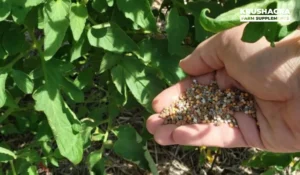Introduction
The agricultural industry is witnessing a growing demand for sustainable and eco-friendly practices in crop protection. Biopesticides, derived from natural sources, offer a promising alternative to conventional chemical pesticides. In the context of horticulture and floriculture crops, biopesticides play a vital role in combating the pervasive downy mildew disease. In this article, we will delve into the world of biopesticides and explore their efficacy in controlling downy mildew, while also highlighting their environmental benefits.
Understanding Downy Mildew
Downy mildew is a common and destructive fungal disease that affects a wide range of horticulture and floriculture crops, including grapes, lettuce, cucumbers, roses, and many more. It is caused by various species of the oomycete pathogen, belonging to the Peronosporales order. The disease thrives in humid conditions, manifesting as yellowish or pale green spots on the upper leaf surface, followed by a fuzzy, white or grayish growth on the lower leaf surface.
The Role of Biopesticides in Controlling Downy Mildew
Biopesticides offer an effective and sustainable approach to managing downy mildew in horticulture and floriculture crops. These products are derived from natural substances, such as microbes, plant extracts, and biochemicals, which harness the inherent defense mechanisms of plants or directly target the pathogens causing the disease. Let’s explore some key biopesticide categories and their effectiveness against downy mildew:
Microbial Biopesticides:Microbial biopesticides contain beneficial microorganisms, such as fungi, bacteria, or viruses, that suppress the growth and activity of downy mildew pathogens. One prominent example is the use of antagonistic fungi, such as Trichoderma spp. and Ampelomyces quisqualis, which compete with the pathogen for nutrients and space, thereby inhibiting its growth. Certain bacterial strains, like Pseudomonas fluorescens, produce antimicrobial compounds that are toxic to downy mildew spores and mycelium, effectively reducing disease severity.
Plant Extract Biopesticides:Plant extracts derived from neem, garlic, cinnamon, and other botanical sources have shown promise in controlling downy mildew. These extracts contain bioactive compounds with antifungal properties, such as azadirachtin in neem, allicin in garlic, and cinnamaldehyde in cinnamon. The application of plant extract biopesticides disrupts the pathogen’s life cycle, inhibiting spore germination, mycelial growth, and the formation of infection structures.
Biochemical Biopesticides:Biochemical biopesticides encompass naturally occurring compounds, such as enzymes, proteins, or other secondary metabolites, that target specific biochemical processes in downy mildew pathogens. For instance, chitosan, a derivative of chitin found in crustacean shells, forms a protective film on the plant surface, inhibiting pathogen penetration and reducing disease incidence. Other examples include phenolics, saponins, and essential oils, which exhibit antifungal properties and modulate plant defense responses.
Benefits of Biopesticides for Downy Mildew Control
The use of biopesticides to combat downy mildew offers several advantages over conventional chemical pesticides:
Environmental Safety: Biopesticides are inherently safer for the environment, as they are derived from natural sources and break down more rapidly, minimizing residue accumulation and reducing the risk of environmental contamination.
Reduced Toxicity and Residue Levels: Biopesticides are generally less toxic to humans, beneficial organisms, and non-target organisms. They also have lower residual levels, ensuring the safety of consumers and minimizing the impact on beneficial insects, pollinators, and the overall ecosystem.
Resistance Management: Continuous reliance on chemical pesticides can lead to the development of resistance in downy mildew pathogens. Biopesticides provide an alternative mode of action, reducing the risk of resistance development and preserving their efficacy over the long term.
Integrated Pest Management (IPM) Compatibility: Biopesticides seamlessly integrate with IPM strategies, promoting a holistic and sustainable approach to disease management. They can be used in combination with cultural practices, such as crop rotation, sanitation, and optimized irrigation, to enhance their effectiveness.
Pre-harvest Interval (PHI) Benefits: Many biopesticides have shorter or zero PHI requirements, allowing growers to harvest their crops sooner after application. This flexibility is particularly advantageous for high-value horticulture and floriculture crops, where timely harvesting is crucial.
Best Practices for Biopesticide Application:
To ensure optimal efficacy in controlling downy mildew, it is essential to follow these best practices when using biopesticides:
Proper Timing: Apply biopesticides at the recommended stage of crop growth and disease development, targeting the vulnerable phases of the downy mildew life cycle. Early detection and preventive applications can significantly reduce disease severity.
Uniform Coverage: Achieve thorough and uniform coverage of the plant foliage, including both upper and lower leaf surfaces. Pay special attention to the areas prone to downy mildew infection, such as dense canopies or areas with poor air circulation.
Application Frequency: Biopesticides may require multiple applications to effectively manage downy mildew, especially under severe disease pressure or during periods of high humidity. Follow the recommended application intervals to maintain disease suppression.
Compatibility Testing: Before integrating biopesticides into a disease management program, conduct compatibility tests with other agrochemicals to avoid any adverse interactions that could reduce efficacy or cause phytotoxicity.
Record-Keeping and Evaluation: Maintain detailed records of biopesticide applications, including dates, rates, and observations. Regularly evaluate the effectiveness of the biopesticide strategy and make adjustments if needed.
Conclusion:
Biopesticides offer a sustainable and eco-friendly solution for controlling downy mildew in horticulture and floriculture crops. By harnessing the power of beneficial microorganisms, plant extracts, and biochemical compounds, biopesticides effectively suppress downy mildew pathogens while minimizing environmental impact. Their compatibility with integrated pest management approaches and favorable safety profiles make them a valuable tool for growers seeking to protect their crops, consumers, and the environment. With continued research and innovation, biopesticides have the potential to revolutionize disease management practices, ensuring a greener and more sustainable future for the agricultural industry.





